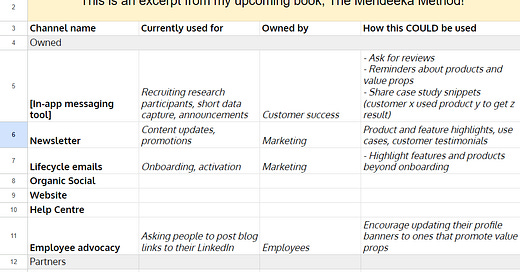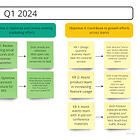📬 In this issue:
The essential sections to any marketing strategy and how to structure it
Thinking in cross-functional campaigns, not silos
🤩Templates🤩
1, 2, cha cha cha, Mehketeers
Strategy is like a dance — no it’s not I’m kidding this isn’t a LinkedIn bro post. Strategy is literally just “who are we targeting and how are we going to reach them” and then it delves into tactics. I know it’s a bit late to be doing a strategy topic, the financial year started a while back here in Australia, but that actually means I’ve seen a few strategy presentations delivered on Struggle Street and that is what planted the seed for this issue.
There’s two ways to go about drawing up your plans: top down, or bottom up. I’m a top down person and if you disagree with that, write your own newsletter, I’ll read it.
The other thing people might disagree with me on is that I firmly believe in business as a whole being a team sport. So many people seem to get upset at the phrase “marketing is an enablement function” but it is??? Marketing enables literally the rest of the sales funnel, which enables the business to run.
A lot of people want to reposition marketing as the star of the show, to which I say no one person or team is the star of the show and if they’re trying to be that, then they’re not a team player. (Also, if you try to be a team player, your individual experience at work will be better as a whole.)
So, basically, all my further statements in this issue will be predicated by the above.
The top-down approach
Start here:
What are the business goals, broken down into revenue (further broken down into new business, renewals, upsell/cross sell)
How are you sales and customer success teams structured (i.e. how many stakeholders do you have to service? Are sales broken into mid market and enterprise? By target industry? Inbound/outbound? List goes on, same for CS)
Followed by looking at some numbers from the past year/quarter:
Out of all revenue generated, how did marketing contribute to this? What % of the dollar amount did marketing bring in as leads?
What channels performed best, in terms of return on marketing spend (RoAS)? How about in terms of closed won volume? In terms of contract value size? Quickets sales cycle?
This is how we’re going to get our big, meaty targets. Seasoned marketers - jump to the line break I promise there’s stuff in here for you!
Aligning targets to revenue
We’re going to work backwards from these end goals, so you’ll need your conversion rates at each stage of the funnel (Lead > MQL > SQL > SAO if you use it > Opportunity > Close Won/Lost > Renewed/Churned), and if you don’t understand the sales cycle from the perspective of Sales, please read Predictable Revenue by Aaron Ross and Marylou Tyler.
Ok, so here’s some basic fake numbers so we can follow along with the maths of all of this. Let’s assume this business has $5M in annual recurring revenue (ARR) at the end of the financial year, and this is for the upcoming year:
Net new revenue:
$500k from enterprise sales (average contract value = $50k, or 10 customers)
$1M from mid market sales (average contract value = 10k, or 100 customers)
Renewal/Churn
5% churn = $4,750,000 in renewals
Upsell/Cross sell
The business has a goal of 1.1 net dollar retention, which means for every dollar at the end of the financial year from existing customers, they want it to grow to $1.10, including accounting for churn.
This means they want existing customer ARR to grow to $5,500,000, so upsell and cross sell goal is $750,000 (adding in the 250k from expected churn, if they can reduce churn, they don’t have to upsell as hard.)
“This sounds like sales targets, not marketing targets”
Now we work backwards with conversion rates to get to our marketing targets. To make things simple for me I’m just going to say this company doesn’t do outbound and 100% of sales came through marketing leads.
The funnel conversion rates are (assuming same numbers for both mid market and enterprise, but you should definitely run the real numbers and separate these goals, or however your sales team is split up):
Lead > MQL = 30%
MQL > SQL = 50%
SQL > SAO = 75%
SAO > Closed won = 50%
Closed won > Renewal = 95%
So how many leads do we need?
173 enterprise leads, and 1730 mid market leads. There’s your targets for lead generation. You might want to split it evenly over 12 months, front load it, or move the numbers up and down according to seasonality. Months with school holidays, for example, you might have a lower target. The calendar can also be aligned to conferences and events, but we’ll get to that later.
This is the line break: Thinking in cross-functional campaigns, not silos
Within any one campaign, there’s a lot of little pieces. There’s a piece of content, the social media posts that go with it, the emails to promote it, potentially paid media, some SEO work, maybe even PR, setting the sales team up with how to use it as an excuse to reach out to prospects who’ve ghosted them.
So why then, do we present strategies broken down into functions of marketing? This quarter, the content team is going to do ABC, the lead gen team is going to do 123, and the digital team is doing XYZ. (Or, if you’re a solo marketer, your to-do list for any given day.)
I mean, life is all grey areas, so really there should be a mix of the two. I’m just throwing this out there, but 60% cross-functional work, 40% keeping your house in order and continuous improvement work.
If you read my previous strategy building advice, using an OKR called “be/become a centre for excellence” is one I put in every year or quarter:
The idea is that you put all your house cleaning projects in there, and that should always be built into your plan to give you the breathing space to actually do it.
Back to the main point
Building your whole strategy and calendar with all of this cross functional work considered from day one, you’ll present a way more coherent strategy, and you/your team members will actually have the forewarning to build this into your capacity.
When creating your strategy, think of your targets/big rocks/goals/whatever your company calls them, in terms of a campaign. How are we (the marketing sub functions) going to do work that rolls up to this? How can we all contribute to this bigger goal, in a cohesive, targeted way?
I don’t watch sports, but even I can see the sports analogy here. Your individual team members all have distinct positions that get the team collectively closer to the goal. If you’re not running drills in how to work together, when you’re on the field you just look like a bunch of toddlers running and falling over.
How can you hand off work between functions better?
In what order should work happen, for a smooth waterfall effect?
Who has sign off on all the pieces of work? When can something go live?
What’s the reporting and retrospective process on completed work?
These are all things to practice and turn into a playbook that you iterate on. Go sports!
A few templates
A quick layout of what you should include in your strategy deck, and what to say when. You can make it look a lot better than I did, that’s for sure.
Make a copy of this and fill it in with your org’s channels and the details in each column (honestly, a short exercise you’ll thank me for later.)
Matrix might be overpromising what this is. It’s pretty simple, but strategies should be simple. It means they’re focused, well defined, and executable.
These last two links are from the same spreadsheet, but will take you to the correct tabs. There’s quite a few things that have accumulated in here over the seasons, so feel free to explore!
My most common question lately
I don’t know what’s in the water but in the past week I’ve had so many people ask me how far in advance I write these, so here’s the answer if you’re curious.
I write issues from the top to the bottom, in order, and I started this issue on Sunday night, wrote the first section, continued on Monday night and wrote the middle, and it’s Tuesday at 10:39pm as I finish this email, to be sent on Wednesday at 10:30am.
In previous seasons I’ve been more organised and had 1-2 issues prepared in advance, this season not so much!
See you next week - I’ll be more prepared, I promise (I’ve done the prep work already, go me.)
Kayla





